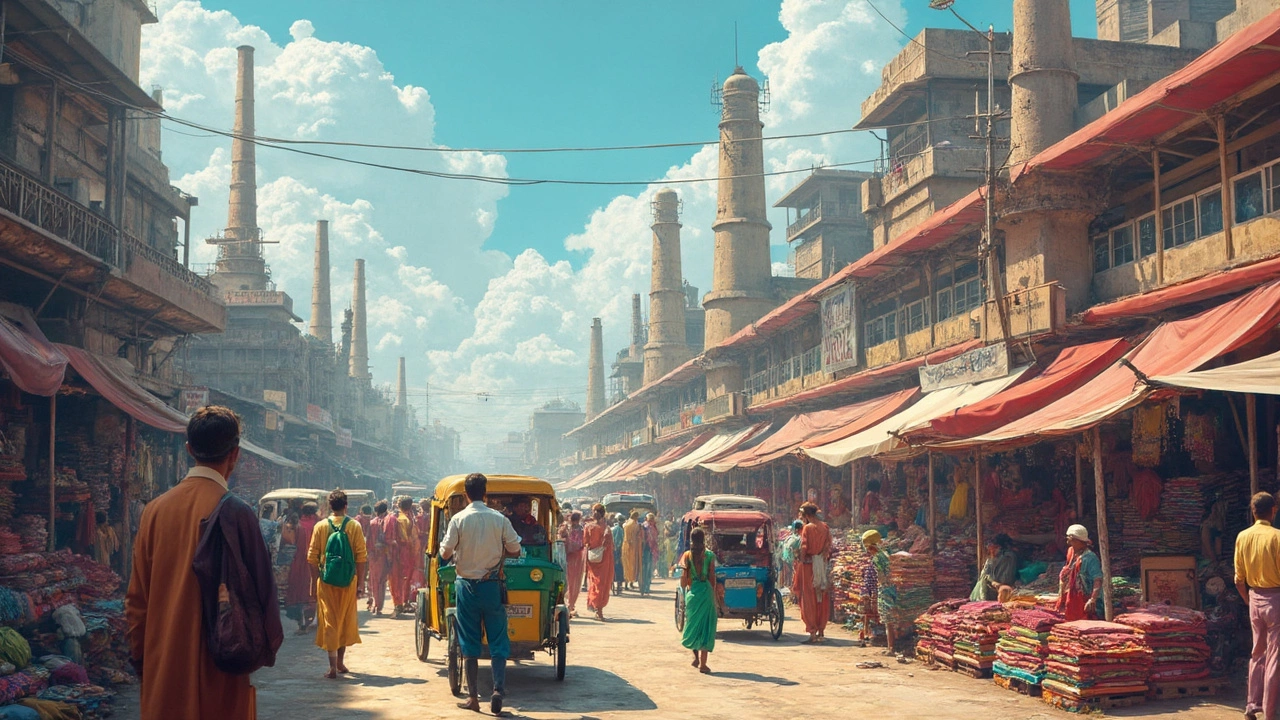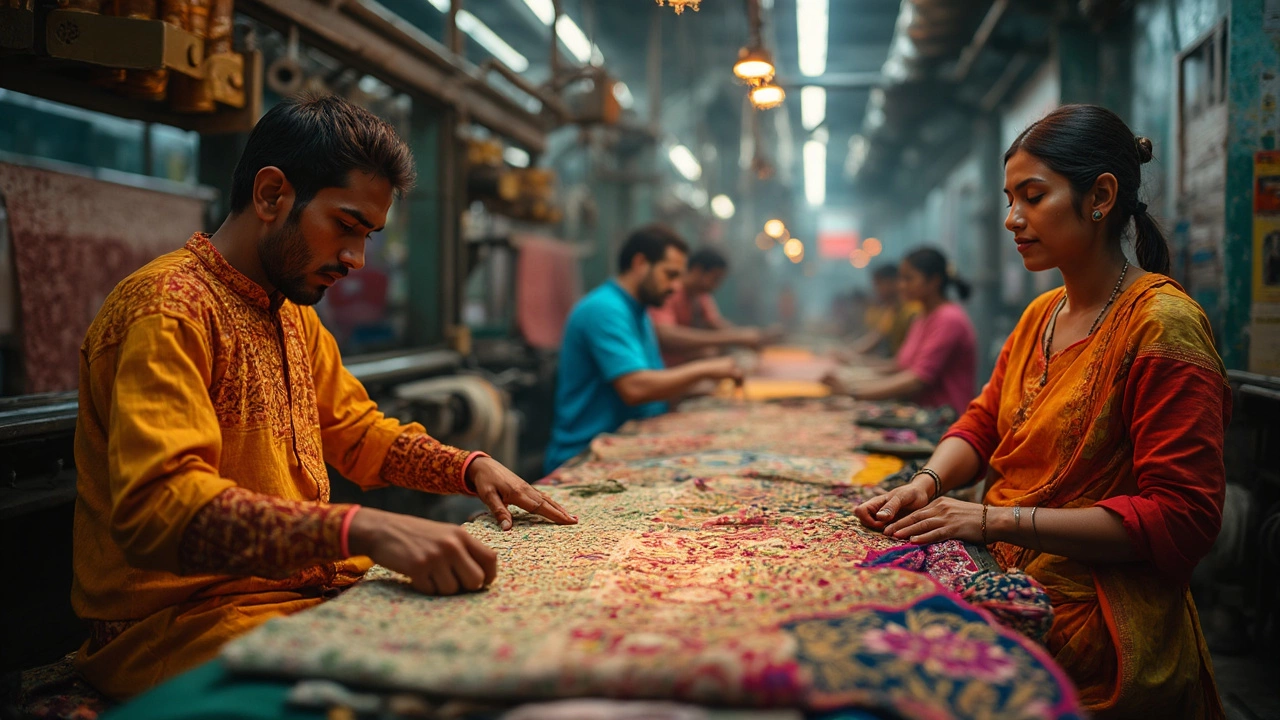 Jun, 10 2025
Jun, 10 2025
Surat gets called the “fabric capital of India” for a reason. If you walk through its buzzing streets, you’ll see textile mills everywhere—churning out everything from simple cotton to rich silk. About 90% of the country’s polyester fabric comes out of Surat alone. That’s no small feat.
It’s not just about making fabric. Surat is a magnet for textile manufacturers and buyers from all over India. If you want to source sarees, dress materials, or even cut-piece fabrics at wholesale rates, this city is where deals are made. Factories run almost non-stop, jobs are easy to find, and the industry here is always looking for new talent and better tech. Think of Surat as a place where tradition meets huge business potential.
If you’re involved with textiles—whether you’re buying, selling, or just curious about how fabric gets to your wardrobe—Surat should be on your radar. Tapping into its market isn’t as intimidating as you’d imagine, especially if you know where to look and which local players are dependable. Hang around the right markets, and you’ll spot trends before the rest of the country catches on.
- Meet India's Fabric King: Surat
- A City Woven with Opportunity
- How Surat Dominates the Textile Scene
- Tips for Textile Buyers and Entrepreneurs
Meet India's Fabric King: Surat
If you’re talking about fabrics in India, Surat always gets a mention. This city in Gujarat isn’t just big, it’s massive when it comes to textiles. Ask anyone working in the industry, and Surat is where a huge chunk of their material comes from.
Here’s why people call Surat the fabric capital of India—the city is home to over 400 textile mills and 650,000 power looms. If you stacked up all the fabric produced here in a year, you’d get close to 30 million meters each day. There’s no city in India—or even Asia—that beats that kind of output for man-made fabrics.
| Stat | Surat Value |
|---|---|
| Textile Factories | 400+ |
| Power Looms | 650,000 |
| Daily Fabric Output | 30 million meters |
| Employment (direct/indirect) | 1 million+ |
| % of Indian Polyester Production | 90% |
But the story isn’t just numbers. Surat’s markets, like the famous Ring Road and Textile Market, are packed with traders every morning. Deals happen fast, often in bulk. Retailers from Delhi, Mumbai, Kolkata, and even small towns come here to snap up fabric rolls before anyone else. If you’ve ever worn an affordable saree or dress from a local shop, there’s a good chance that material started out in this city.
The local government and business clubs have set up strong networks for freight and shipping. That means orders get processed quickly, so no one’s waiting around for stock. Plus, Surat’s known for adapting fast. Whenever a new trend hits—whether it’s digital prints, sequins, or eco-friendly fabrics—factories here switch gears without missing a beat.
Surat’s journey isn’t just about quantity. The city keeps adding modern weaving machines and digital dyeing tech to keep its edge. That makes it a hotspot for anyone in the textile game—from job-seekers to entrepreneurs wanting a slice of a big market.
A City Woven with Opportunity
Think of Surat as a city that runs on fabric. It’s been the backbone of India’s textile game for decades. With over 450,000 power looms buzzing day and night, Surat’s textile industry creates jobs for nearly 700,000 people. There’s real money at stake here—the city’s textile turnover was estimated at around ₹50,000 crore in 2024, making it a major engine of the local economy.
Surat isn’t stuck in the past, though. While you’ll find traditional handloom sarees in spots like the Ring Road textile market, most of the action comes from modern factories using state-of-the-art machines. This combo of old and new keeps the city ahead in the fabric capital of India race.
If you’re wondering what keeps buyers and manufacturers coming back, here’s a quick hit list:
- Massive variety: From polyester to fancy chiffon or crepe, the choices are endless.
- Competitive pricing: Because there’s so much production, prices stay sharp.
- Quick turnaround: Local supply chains keep production and deliveries fast.
- Events: Trade shows like the Surat International Textile Expo (SITE) bring in new partnerships and tech every year.
Here’s a look at Surat’s 2024 textile production at a glance:
| Fabric Type | Annual Production (Million Meters) |
|---|---|
| Polyester | 3,000 |
| Silk/Blended | 250 |
| Cotton | 160 |
If you want to crack into India’s textile market—for business, sourcing, or even job hunting—Surat makes it simple. The infrastructure is solid, the workforce is experienced, and you don’t have to jump through hoops to connect with big players. Lots of startups, especially those dealing with digital printing and designer wear, are finding their feet here.

How Surat Dominates the Textile Scene
When people talk about the fabric capital of India, they're almost always talking about Surat—and there's solid proof to back that up. The city isn't just big in textiles; it's a giant. Surat produces nearly 30 million meters of raw fabric every single day. Wrap your mind around that number! From polyester to fancy georgette, Surat brings it all to the table.
Walk through the Surat Textile Market, and you’ll notice it's not just about quantity. The city has over 700,000 power looms running day and night, weaving massive amounts of fabric for use all over India and even worldwide. As of 2024, almost 65% of India's man-made fiber is spun, dyed, or finished here before it hits shop shelves.
Surat also moves smart with tech. While old-style handlooms can still be found, most businesses have switched to automated looms and digital printing. This upgrade helps local manufacturers react quickly to changing trends—so if pastel florals are hot for summer, Surat shops will have rolls ready before you know it.
If you look at exports, Surat’s fabric reaches over 60 countries, including popular spots like Dubai, Bangladesh, Nigeria, and the UK. The city’s network is tight, with suppliers, dyeing hubs, and finishing units all working together to keep delivery times super fast and prices low.
- About 90% of India’s polyester yarn comes from this city.
- The annual turnover from textiles here blows past ₹50,000 crore (that’s over $6 billion).
- There’s a huge focus on eco-friendly dyeing and water-saving tech, a big shift as the world wants cleaner production.
So if you’re a buyer, Surat offers easy access to almost every type of fabric you could want. Prices are tough to beat, and the sheer variety means you’ll find what you need—even in bulk. The city’s support systems, like strong transport links and responsive local brokers, keep things running smoothly for manufacturers and traders alike.
Tips for Textile Buyers and Entrepreneurs
If you’re diving into the fabric capital of India, you’ll want practical steps for getting the best out of Surat’s massive textile industry. Whether you’re buying fabrics for your shop or thinking of starting a small brand, knowing how Surat works on the inside will save you time and money.
Here’s what you should focus on:
- Know the Markets: Surat’s textile trade happens mostly in places like the Ring Road, Bombay Market, and Textile Market. These aren’t just shopping zones—they’re networking goldmines. If you can, walk these markets to get a feel for current trends and pricing.
- Double-Check Quality: Not every fabric roll is the same. Ask for samples and check the fabric under good lighting. Some buyers even keep a small magnifying glass handy to spot flaws, as quality can jump even between lots from the same mill.
- Bargain Smart: Prices can shift a lot based on how much you buy. Don’t accept the first price thrown at you. Dealers expect buyers to negotiate—so counter with another offer and don’t rush.
- Trusted Suppliers Matter: Word gets around fast in Surat about who delivers reliably. Ask locals or other business owners to point you toward trusted mills or traders. Many reputable dealers even have easy WhatsApp support with catalogs.
- Keep an Eye on GST and Invoices: Most legitimate business in Surat is GST-billed, so don’t skip paperwork for a slightly lower rate. Having a proper invoice will protect you from nasty surprises if something goes wrong with your order.
- Tap Into Technology: Surat textile manufacturers have started to upload their product catalogs online—websites and even on Instagram. This means you can do a lot of research before showing up. If a supplier can’t provide high-res images or prompt replies, think twice.
- Visit During Textile Fairs: Surat hosts multiple textile exhibitions every year, like the Surat International Textile Expo. These events are packed with both established brands and fresh faces, all eager to strike deals. Even if you don’t buy anything on the spot, you’ll leave with loads of contacts.
Surat’s fabric business isn’t just about buying and selling. It's about building relationships. If you play it smart and stay connected, you can spot opportunities before most people even know what’s coming. Always be clear with your orders, confirm timelines, and keep a pulse on what’s moving fast in the market. You’ll find that the city has room for everyone willing to learn and adapt.